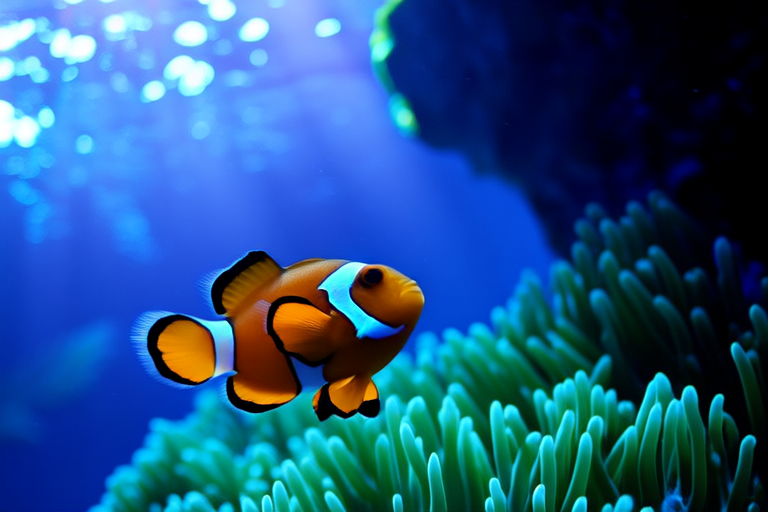The Ultimate Guide to Care for a Happy and Healthy Clownfish
Clownfish, also known as anemonefish, are among the most popular choices for saltwater aquariums due to their vibrant colors and engaging behavior. However, providing optimal care requires understanding various aspects of their biology and habitat. This guide will cover everything from setting up the perfect tank to maintaining good health through proper diet and regular maintenance.
Suitable Tank Setup
Choosing the right tank size is crucial when considering a clownfish. A minimum volume of 30 gallons (114 liters) is recommended for one pair or small group of clownfish. Larger tanks provide more swimming space and better water quality management, which can significantly improve your fish’s overall health.
Ensure that the tank has adequate filtration systems capable of handling biological, mechanical, and chemical filtration processes. Good circulation helps maintain oxygen levels while removing harmful substances like ammonia and nitrites.
Decorations such as live rock, corals, and plants mimic natural reef environments where clownfish thrive. Providing hiding spots and caves encourages territorial behavior and reduces stress.
Water Parameters
Maintaining stable water conditions is vital for keeping clownfish healthy. Ideal temperature ranges between 76°F – 82°F (24°C – 28°C), with pH levels between 8.1 – 8.4. Salinity should be kept at around 1.023 – 1.025 specific gravity.
Regular testing using reliable test kits ensures that these parameters remain within acceptable limits. It’s advisable to perform partial water changes weekly or biweekly, depending on the stocking density and bio-load of your tank.
Diet
Clownfish are omnivorous feeders; they consume both plant matter and small animals. In captivity, offering a varied diet promotes balanced nutrition. High-quality flake foods, pellets, frozen brine shrimp, mysis shrimp, and occasional blanched vegetables can form part of their meals.
Avoid overfeeding, as excess food contributes to poor water quality and obesity issues. Feed them twice daily in small portions, ensuring all food items are consumed within five minutes.
Common Diseases
Despite being relatively hardy, clownfish may still fall ill under certain circumstances. Common ailments include marine ich (Cryptocaryon irritans), velvet disease (Oodinium), and bacterial infections.
Early detection and treatment are key to preventing widespread outbreaks. Quarantine new additions before introducing them into the main tank, and monitor existing inhabitants closely for signs of distress or abnormal behavior.
Tank Mates Compatibility
Selecting compatible tank mates enhances the social dynamics within the aquarium. Clownfish generally coexist peacefully with other peaceful species provided there isn’t direct competition for resources.
Avoid housing them alongside aggressive or predatory fish that might view them as prey. Some suitable companions include damselfish, cardinalfish, blennies, gobies, and some species of wrasse.
Breeding Tips
Breeding clownfish involves creating favorable environmental conditions conducive to spawning activities. Establishing a bonded pair is essential; once mated, they become fiercely protective of their eggs.
Provide ample flat surfaces for egg deposition, such as glass panes or designated spawning slates. Increase feeding frequency leading up to potential spawning periods to stimulate reproductive behaviors.
Monitor the eggs closely after fertilization occurs, ensuring proper development by maintaining optimal water conditions. Newly hatched larvae require specialized care involving separate rearing tanks equipped with appropriate microfauna diets.
Regular Maintenance Routines
To ensure long-term success in caring for your clownfish, establish consistent maintenance practices:
- Weekly Water Changes: Perform 10%-20% partial water exchanges weekly to dilute accumulated toxins.
- Cleaning Equipment: Regularly clean filters, heaters, and decorations to prevent clogging and contamination.
- Monitoring Parameters: Test water regularly for critical factors like ammonia, nitrite, nitrate, pH, and salinity.
- Feeding Schedule: Stick to scheduled feeding times to avoid overfeeding and promote regular digestion.
In conclusion, providing excellent care for clownfish demands attention to detail across multiple facets of husbandry. By focusing on creating ideal living spaces, monitoring health indicators, selecting appropriate companions, and adhering to best practices regarding nutrition and hygiene, you set yourself up for raising thriving populations of these fascinating creatures.
